Abstract
1. Concentration-effect relationships of midazolam were assessed in an open study in six healthy volunteers. Saccadic eye movements and EEG parameters derived by fast Fourier transform (FFT) and aperiodic analysis (AP) were used to quantify drug effects. 2. Midazolam was infused at a rate of 0.6 mg kg-1 h-1 for a maximum of 15 min. Hypnotic effects were avoided by terminating infusions when subjects could no longer perform the eye movement test properly. 3. Wake-sleep transitions could be recognized through frequent observation of eye movements. The dose needed to reach maximum conscious sedation averaged 0.10 mg kg-1, ranging from 0.06 to 0.13 mg kg-1. 4. Sigmoidal concentration-effect relationships were found for EEG beta-amplitudes in five of six subjects, with average EC50 values (+/- s.d.) of 120 +/- 54 ng ml-1 for FFT and 104 +/- 40 ng ml-1 for AP. For the 'total number of waves' in the beta frequency range (AP) an average (n = 6) EC50 of 63 +/- 37 ng ml-1 was found. Changes in EEG alpha-amplitudes were found in three subjects, resulting in an average EC50 value of 55 +/- 32 ng ml-1. 5. For saccadic peak velocity (PV) concentration-effect relationships were linear in five subjects and sigmoidal in one. The maximal measured decrease in PV averaged -44 +/- 9%. 6. The differences in concentration-effect relationships for various effect parameters call for further studies with emphasis on the external validity and reproducibility of data. In such studies the dose needed to reach wake-sleep transition may be used as a relevant clinical end-point.
Full text
PDF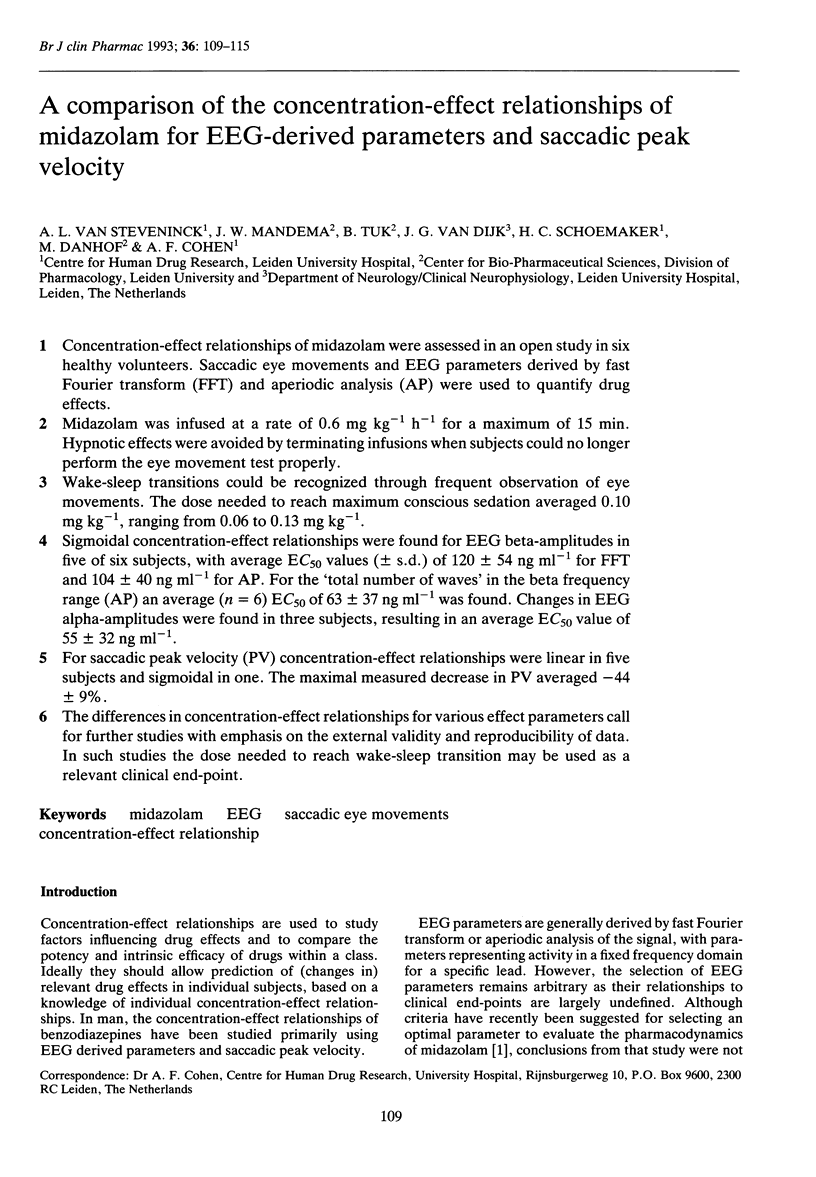
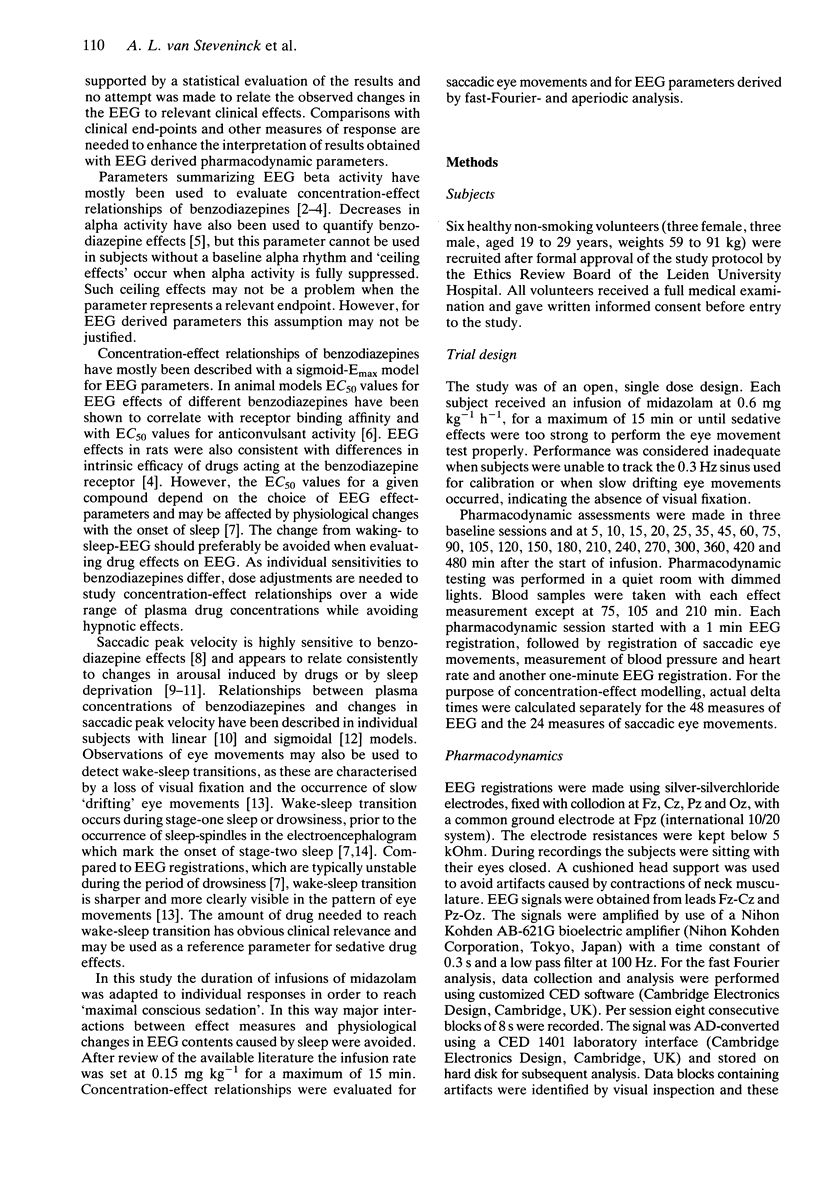
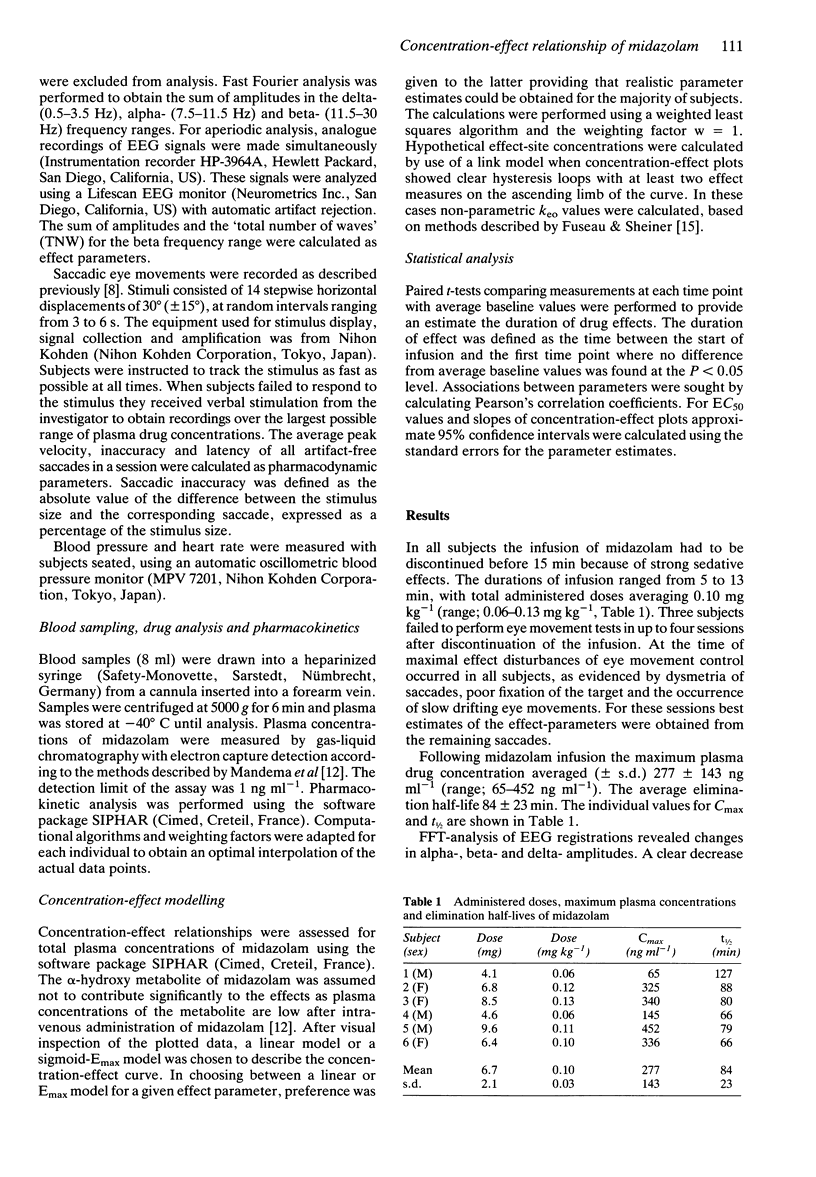

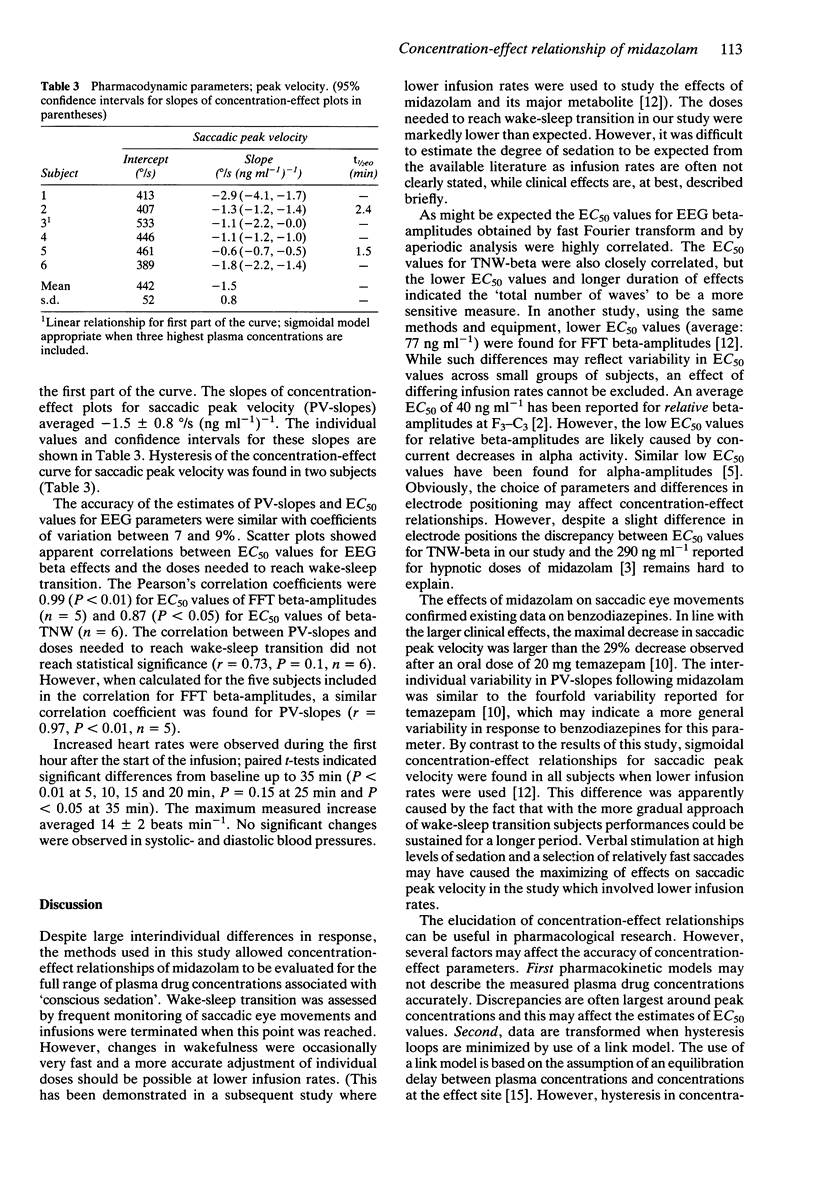
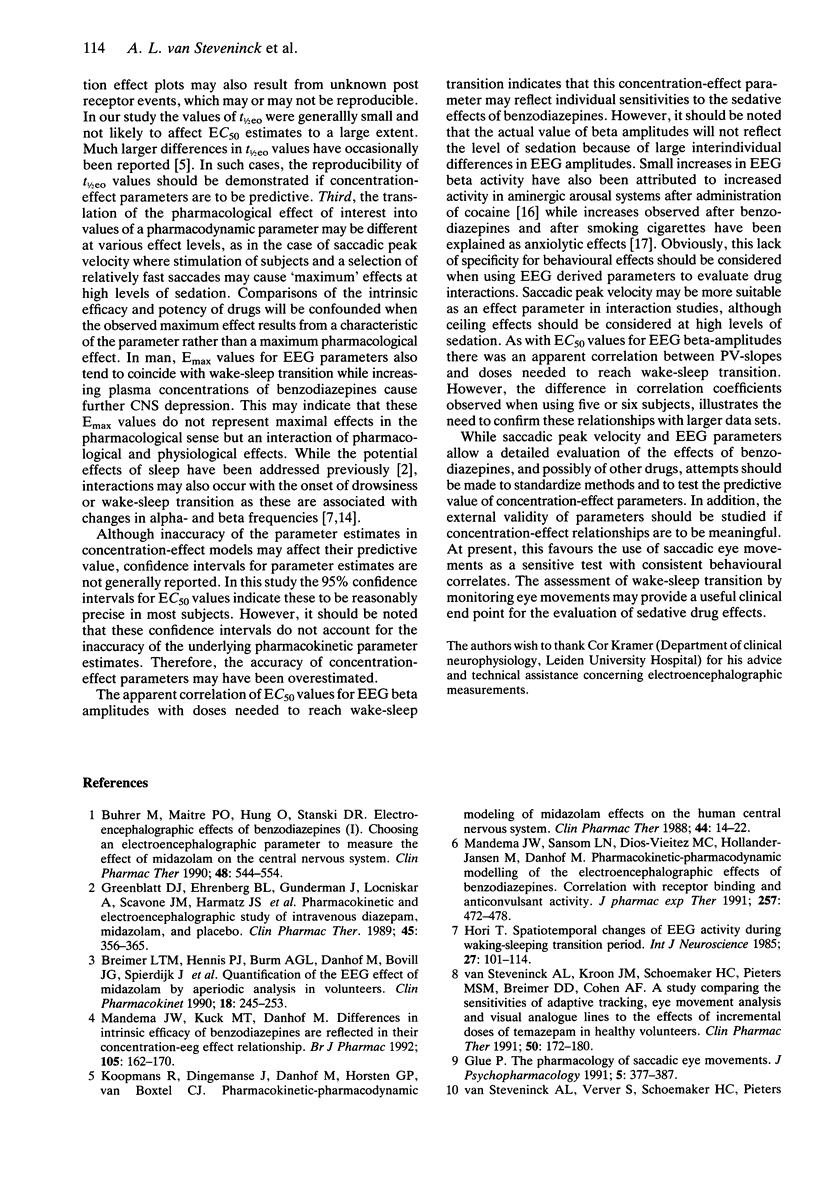
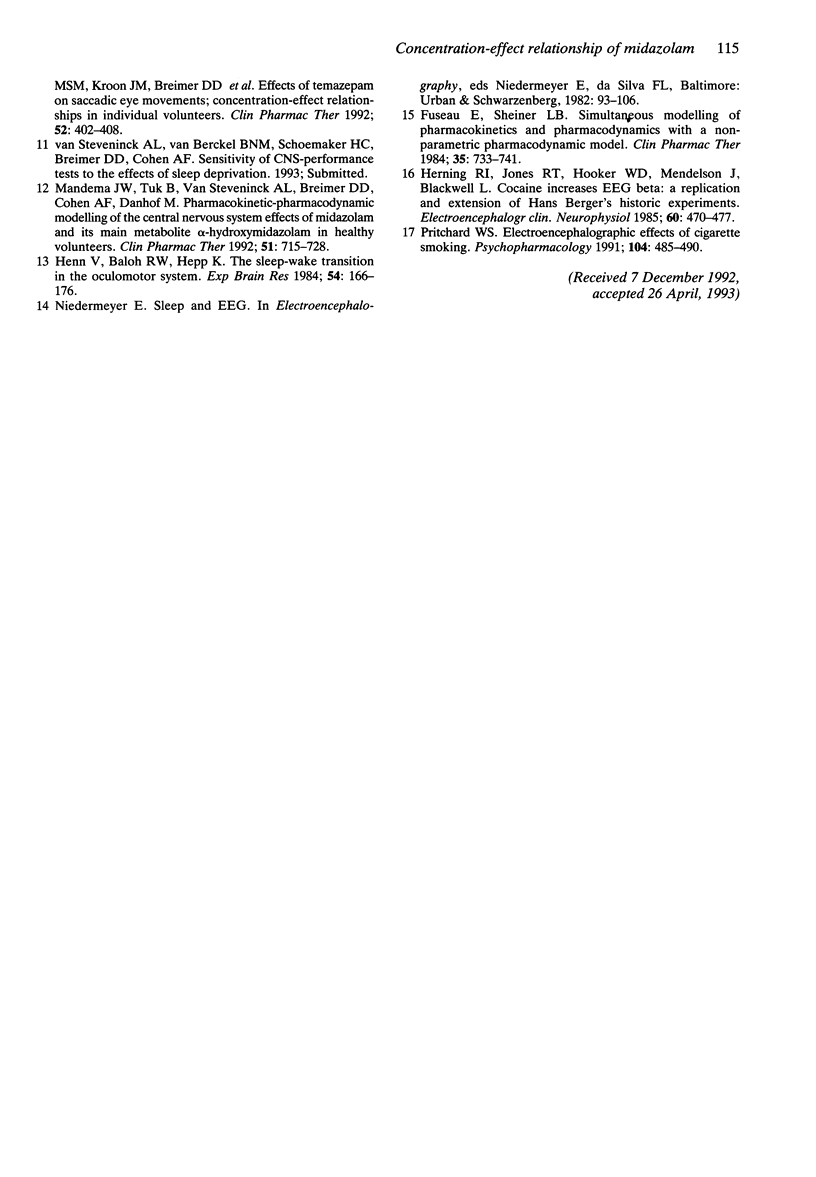
Selected References
These references are in PubMed. This may not be the complete list of references from this article.
- Breimer L. T., Hennis P. J., Burm A. G., Danhof M., Bovill J. G., Spierdijk J., Vletter A. A. Quantification of the EEG effect of midazolam by aperiodic analysis in volunteers. Pharmacokinetic/pharmacodynamic modelling. Clin Pharmacokinet. 1990 Mar;18(3):245–253. doi: 10.2165/00003088-199018030-00006. [DOI] [PubMed] [Google Scholar]
- Bührer M., Maitre P. O., Hung O., Stanski D. R. Electroencephalographic effects of benzodiazepines. I. Choosing an electroencephalographic parameter to measure the effect of midazolam on the central nervous system. Clin Pharmacol Ther. 1990 Nov;48(5):544–554. doi: 10.1038/clpt.1990.191. [DOI] [PubMed] [Google Scholar]
- Fuseau E., Sheiner L. B. Simultaneous modeling of pharmacokinetics and pharmacodynamics with a nonparametric pharmacodynamic model. Clin Pharmacol Ther. 1984 Jun;35(6):733–741. doi: 10.1038/clpt.1984.104. [DOI] [PubMed] [Google Scholar]
- Greenblatt D. J., Ehrenberg B. L., Gunderman J., Locniskar A., Scavone J. M., Harmatz J. S., Shader R. I. Pharmacokinetic and electroencephalographic study of intravenous diazepam, midazolam, and placebo. Clin Pharmacol Ther. 1989 Apr;45(4):356–365. doi: 10.1038/clpt.1989.41. [DOI] [PubMed] [Google Scholar]
- Henn V., Baloh R. W., Hepp K. The sleep-wake transition in the oculomotor system. Exp Brain Res. 1984;54(1):166–176. doi: 10.1007/BF00235828. [DOI] [PubMed] [Google Scholar]
- Herning R. I., Jones R. T., Hooker W. D., Mendelson J., Blackwell L. Cocaine increases EEG beta: a replication and extension of Hans Berger's historic experiments. Electroencephalogr Clin Neurophysiol. 1985 Jun;60(6):470–477. doi: 10.1016/0013-4694(85)91106-x. [DOI] [PubMed] [Google Scholar]
- Hori T. Spatiotemporal changes of EEG activity during waking-sleeping transition period. Int J Neurosci. 1985 Jul;27(1-2):101–114. doi: 10.3109/00207458509149139. [DOI] [PubMed] [Google Scholar]
- Koopmans R., Dingemanse J., Danhof M., Horsten G. P., van Boxtel C. J. Pharmacokinetic-pharmacodynamic modeling of midazolam effects on the human central nervous system. Clin Pharmacol Ther. 1988 Jul;44(1):14–22. doi: 10.1038/clpt.1988.106. [DOI] [PubMed] [Google Scholar]
- Mandema J. W., Kuck M. T., Danhof M. Differences in intrinsic efficacy of benzodiazepines are reflected in their concentration-EEG effect relationship. Br J Pharmacol. 1992 Jan;105(1):164–170. doi: 10.1111/j.1476-5381.1992.tb14229.x. [DOI] [PMC free article] [PubMed] [Google Scholar]
- Mandema J. W., Sansom L. N., Dios-Vièitez M. C., Hollander-Jansen M., Danhof M. Pharmacokinetic-pharmacodynamic modeling of the electroencephalographic effects of benzodiazepines. Correlation with receptor binding and anticonvulsant activity. J Pharmacol Exp Ther. 1991 Apr;257(1):472–478. [PubMed] [Google Scholar]
- Mandema J. W., Tuk B., van Steveninck A. L., Breimer D. D., Cohen A. F., Danhof M. Pharmacokinetic-pharmacodynamic modeling of the central nervous system effects of midazolam and its main metabolite alpha-hydroxymidazolam in healthy volunteers. Clin Pharmacol Ther. 1992 Jun;51(6):715–728. doi: 10.1038/clpt.1992.84. [DOI] [PubMed] [Google Scholar]
- Pritchard W. S. Electroencephalographic effects of cigarette smoking. Psychopharmacology (Berl) 1991;104(4):485–490. doi: 10.1007/BF02245654. [DOI] [PubMed] [Google Scholar]
- van Steveninck A. L., Schoemaker H. C., Pieters M. S., Kroon R., Breimer D. D., Cohen A. F. A comparison of the sensitivities of adaptive tracking, eye movement analysis and visual analog lines to the effects of incremental doses of temazepam in healthy volunteers. Clin Pharmacol Ther. 1991 Aug;50(2):172–180. doi: 10.1038/clpt.1991.122. [DOI] [PubMed] [Google Scholar]
- van Steveninck A. L., Verver S., Schoemaker H. C., Pieters M. S., Kroon R., Breimer D. D., Cohen A. F. Effects of temazepam on saccadic eye movements: concentration-effect relationships in individual volunteers. Clin Pharmacol Ther. 1992 Oct;52(4):402–408. doi: 10.1038/clpt.1992.162. [DOI] [PubMed] [Google Scholar]


